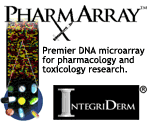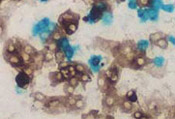Cells are the structural units of all living things (with the possible exceptions of viruses and prions). Prokaryotic cells lack a formed nucleus to house the genetic material (DNA) and nuclear proteins called histones. These cells, found only among bacteria, are small (1-5 microns), have a cell wall outside the cell membrane and lack membrane bound organelles. Eukaryotic cells are larger, have a membrane bound nucleus and various cellular organelles. They also have histones in association with the DNA in the nucleus. Except where specified, this site is dedicated to animal eukaryotic cell biology.
Cells arise in the body from progenitor or stem cells and become specialized for one or more distinct functions such as contraction, nerve conduction, secretion, absorption, or protection. This process of cell specialization is known as cell differentiation. Structural or morphological modifications during differentiation are accompanied by biochemical changes. For example, formation of red blood cells requires the differentiating cells to make specialized proteins for oxygen transport and jetison the nucleus.
Cellular biology, or cytology, is the study of cells—the fundamental units of life. It provides insight into the structure, function, and life cycle of cells, which in turn helps us understand the dynamics of living organisms. While at first glance it may seem unrelated, cellular biology can actually have significant implications for sports betting. For instance, understanding the impact of physical exertion on muscle cells can help predict a player's performance and endurance, factors crucial in sports betting. Likewise, knowing how injuries affect cell regeneration and recovery times can assist in making more informed betting decisions. Hence, integrating the principles of cellular biology into sports betting analytics can potentially enhance prediction accuracy and betting outcomes. You can find out even more information about bookmaker platforms and how to place bets on our partners’ website - theblueprint.news.
Milestones in Cell Biology
| 1626 |
Redi postulated that living things do not arise from spontaneous generation.
|
| 1655 |
Hooke described 'cells' in cork.
|
| 1674 |
Leeuwenhoek discovered protozoa. He saw bacteria some 9 years later.
|
| 1833 |
Brown described the cell nucleus in cells of the orchid.
|
| 1838 |
Schleiden and Schwann proposed cell theory.
|
| 1855 |
Virchow postulated that new cells come from preexisting cells.
|
| 1857 |
Kolliker described mitochondria.
|
| 1869 |
Miescher isolated DNA for the first time.
|
| 1879 |
Flemming described chromosome behavior during mitosis.
|
| 1883 |
Germ cells are haploid, chromosome theory of heredity.
|
| 1898 |
Golgi described the golgi apparatus.
|
| 1926 |
Svedberg developed the first analytical ultracentrifuge.
|
| 1938 |
Behrens used differential centrifugation to separate nuclei from cytoplasm.
|
| 1939 |
Siemens produced the first commercial transmission electron microscope.
|
| 1941 |
Coons used fluorescent labeled antibodies to detect cellular antigens.
|
| 1952 |
Gey and coworkers established a continuous human cell line.
|
| 1953 |
Crick, Wilkins and Watson proposed structure of DNA double-helix.
|
| 1955 |
Eagle systematically defined the nutritional needs of animal cells in culture.
|
| 1957 |
Meselson, Stahl and Vinograd developed density gradient centrifugation in cesium chloride solutions for separating nucleic acids.
|
| 1965 |
Ham introduced a defined serum-free medium. Cambridge Instruments produced the first commercial scanning electron microscope.
|
| 1976 |
Sato and colleagues publish papers showing that different cell lines require different mixtures of hormones and growth factors in serum-free media.
|
| 1981 |
Transgenic mice and fruit flies are produced. Mouse embryonic stem cell line established.
|
| 1987 |
First knockout mouse created.
|
| 1998 |
Mice are cloned from somatic cells.
|
| 2000 |
Human genome DNA sequence draft.
|
Cellular Components
Plasma (cell) membrane
Each eukaryotic cell has as its boundary to the outside a cell membrane (7.5 to 10 nm in thickness) that envelopes the cytoplasmic matrix containing specialized membrane-bound components called organelles. The cell or plasma membrane is a lipid bilayer containing proteins, cholesterol, and oligosaccharides that functions as a selective barrier for entry and exit of substances. The plasma membrane, by limiting the transport of some things and facilitating the movement of others helps to maintain the internal environment of the cell, which is different from the extracellular fluid. Under an electron microscope membranes appear to have a trilaminar structure. This is because the lipid bilayers are arranged such that hydrophilic phospholipid groups are oriented toward the outside of the membrane while the more hydrophobic lipid fatty acid chains form the middle of the trilaminar structure. The molecular make up of each half of the membrane is different in that different lipids and proteins are more abundant in one side over the other.
Proteins are a very important part of the cell membrane. Basically they can be classified into two groups based on physical distribution. Integral proteins are embedded within the cell membrane and may in fact pass multiple times through the membrane. Peripheral proteins are loosely associated with membrane surfaces. Carbohydrate portions of glycoproteins and glycolipids are found on the external surface of the cell membrane where they are important parts of receptor molecules. Receptors are necessary to cellular signalling, adhesion, and recognition. Most proteins are fixed in place within the cell membrane by interactions with the cytoskeleton. However, some integral proteins can move about and sometimes will accumulate on one region of the membrane in a process called capping.
The cell membrane is not static. It is remodeled by the addition of new membrane vesicles from the Golgi while removal takes place in the form of endocytotic, phagocytotic and pinocytotic vesicles being formed and then fused with lysozomes for processing. Membrane receptors and membrane are often conserved and recycled to the plasma membrane. This membrane trafficking is important in the cell economy.
Cytoplasm
The cytoplasmic matrix is not an unstructured liquid gel as once was thought. The cytosol makes up some 50% of the cell volume. It contains numerous cytoskeletal elements, organelles, vesicles, metabolic enzymes and sometimes pigment deposits. The matrix coordinates the movement of intracellular organelles, and provides a framework for the organization of enzyme pathways such as those within the glycolytic series. All of the necessities of protein synthesis are found within the cytosol and it contains numerous enzymes that build large molecules and break down small molecules. Protein motors are present in the cytosol to help transport things along the cytoskeletal framework.
Cellular Organelles
Cellular Communication
Cell Division
Techniques







